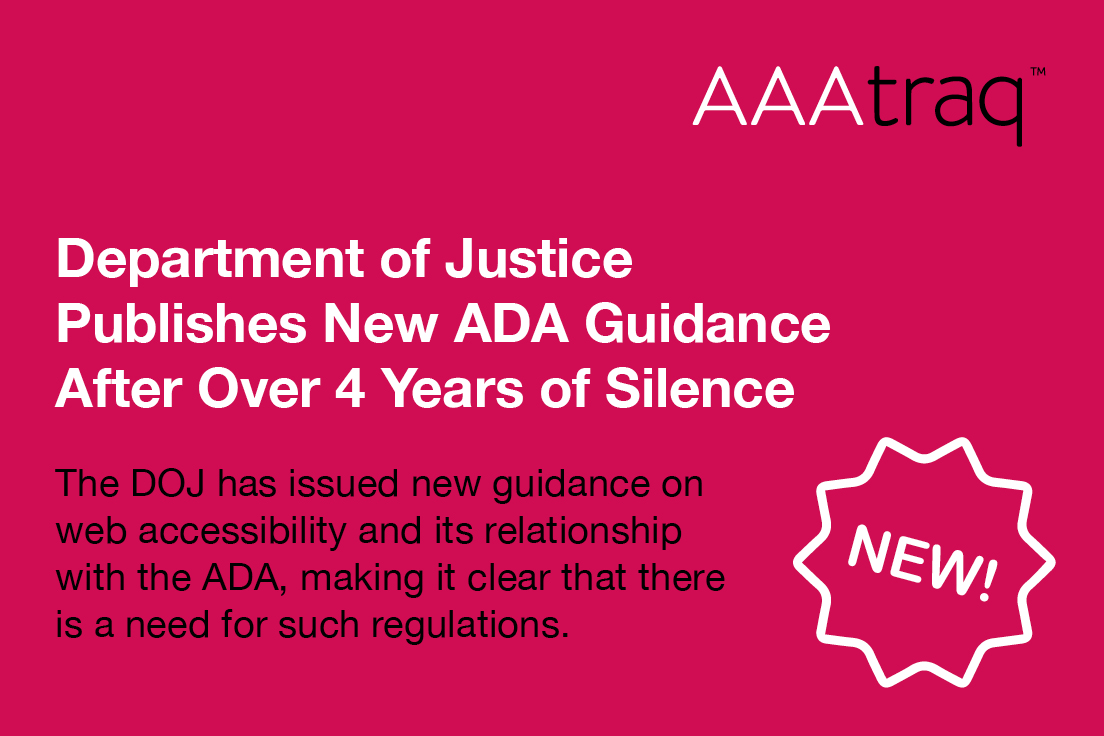Department of Justice Publishes New ADA Guidance After Over 4 Years of Silence
Mar 31 2022
On Friday March 18th, 2022, the Department of Justice (DOJ) issued new guidance on web accessibility and its relationship with the Americans with Disabilities Act of 1990 (ADA).
The guidance ends what has been more than four years of regulatory silence on the matter since the DOJ withdrew their rules regarding website accessibility citing, “The Department is evaluating whether promulgating regulations about the accessibility of Web information and services are necessary and appropriate. Such an evaluation will be informed by an additional review of data and further analysis. The Department will continue to assess whether specific technical standards are necessary and appropriate to assist covered entities with complying with the ADA.” With this new guidance, the DOJ has made it clear that there is a need for such regulations and that their enforcement is an integral part of ensuring that discriminatory practice does not disenfranchise disabled individuals on the internet. So, what does the new guidance tell us?
Guidance Concerning Title II of the ADA
Title II of the ADA says that local and state governments (and their respective agencies) cannot discriminate against disabled individuals in the services, programs, and activities in/for which they engage/facilitate. Some of such activities/provisions have transferred to the web or are being offered on the web. Such services named in the guidance include (but are not limited to): “applying for absentee ballot, paying tickets or fees, filing a police report, attending a virtual town meeting, filing tax documents, registering for school or school programs; and applying for state benefits programs.” The DOJ has long maintained that Title II protections apply to web content produced and maintained by state and local agencies, and thus extend to any services/programs/activities associated with such web content.
Guidance Concerning Title III of the ADA
Title III of the ADA covers businesses that are open to the public (otherwise known as “public accommodations”). Previous iterations of DOJ guidance have been inconsistent with their attitude towards having the ADA apply to web content provided and maintained by privately held businesses that service the public. Such businesses named in the most recent guidance include: “retail stores and other sales or retail establishments; banks; hotels, inns, and offices; food and drink establishments; and auditoriums, theaters, and sports arenas.” Under this new guidance the DOJ has clarified its position (and reaffirms the position it has taken in recent litigation) that the ADA’s requirements for antidiscrimination applies to all public accommodations “including those offered on the web”. While these businesses must provide accessible content, the benchmarks by which a website is deemed to be accessible, and the mechanisms to test such benchmarks has not yet been established at a national level. To date, the DOJ maintains that while an entity must comply with the ADA’s requirements, they have flexibility in how they comply.
What’s new about this guidance?
First, and foremost, the guidance effectively clarifies the position of the DOJ that, in the eyes of the federal government, the ADA’s protections cover public serving websites (websites utilized by the public as an extension of a physical place of public accommodation). Such guidance highlights the need for accessibility on digital platforms that allow users to engage with daily life activities such as online banking, restaurant reservation making, online food shopping, etc. Second, the guidance admits that its enforcement over Title III infractions to be inconsistent without a national standard. Does this mean that the DOJ will issue their own guidance as to a national standard? Will Congress establish one? Or is the government comfortable with the inconsistent application the ADA that has led to a circuit split in judicial decisions on the matter.
Third, the guidance sets forth a new tone on overlays, and outlines their role in the accessibility process as a tool, but not as an answer. Overlays, as defined by the World Wide Web Consortium (W3C), are a “discrete user interface object with which the user can interact.” The guidance reiterates what has become clear: overlays alone are not the answer. When not utilized in conjunction with manual checking, overlays are the perfect device to leave you vulnerable to litigious action. The new guidance, under its “checking for accessibility” section, says:
"Checking for accessibility. Automated accessibility checkers and overlays that identify or fix problems with your website can be helpful tools, but like other automated tools such as spelling or grammar checkers, they need to be used carefully. A “clean” report does not necessarily mean everything is accessible. Also, a report that includes a few errors does not necessarily mean there are accessibility barriers. Pairing a manual check of a website with the use of automated checkers can give you a better sense of the accessibility of your website."1
Finally, the guidance is just another indication that the DOJ is looking to enforce web accessibility anti-discriminatory legislation. As such, businesses must take precautions to limit their exposure to litigious actions. Start by understanding the level of risk associated with your website. To ensure that your websites are inclusive, consider AAAtraq. AAAtraq encourages you to take 60 seconds to understand your own risk position – you can do it, free at https://AAAtraq.com/ (opens in a new window) - no registration required - and results are immediately available and understandable. Green = good - red = bad.
Subscribe to AAAtraq and enjoy complete cover and peace of mind
